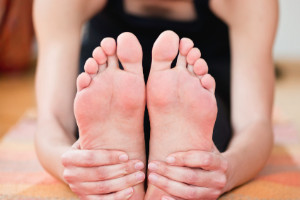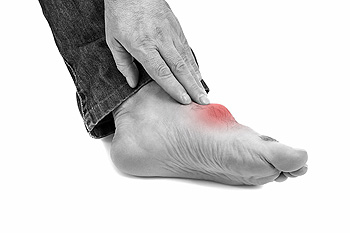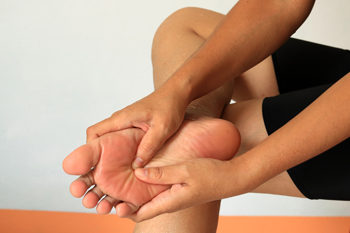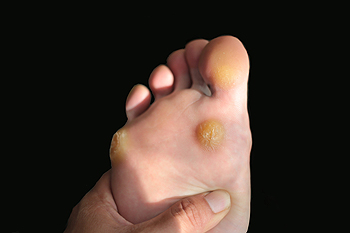Items filtered by date: March 2020
Stretching Before Running
 Many people enjoy the sports of running and jogging, and are generally aware of the importance of preventing running injuries. These types of injuries can include ankle sprains, plantar fasciitis, and stress fractures, which typically can cause severe pain and discomfort. Research has indicated the importance of stopping the activity that caused the injury, as this may allow ample time for the affected foot to heal. It is beneficial to drink plenty of water, and accelerate slowly when jogging or running. Additionally, it may help to perform specific stretching techniques before embarking on a run, as this may help to keep the muscles flexible. If you enjoy running, it is suggested that you consult with a podiatrist to learn about how running injuries may affect the feet.
Many people enjoy the sports of running and jogging, and are generally aware of the importance of preventing running injuries. These types of injuries can include ankle sprains, plantar fasciitis, and stress fractures, which typically can cause severe pain and discomfort. Research has indicated the importance of stopping the activity that caused the injury, as this may allow ample time for the affected foot to heal. It is beneficial to drink plenty of water, and accelerate slowly when jogging or running. Additionally, it may help to perform specific stretching techniques before embarking on a run, as this may help to keep the muscles flexible. If you enjoy running, it is suggested that you consult with a podiatrist to learn about how running injuries may affect the feet.
All runners should take extra precaution when trying to avoid injury. If you have any concerns about your feet, contact Donald Manger, DPM of Associated Podiatric Physicians, PA. Our doctor will treat your foot and ankle needs.
How to Prevent Running Injuries
There are a lot of mistakes a runner can make prior to a workout that can induce injury. A lot of athletes tend to overstretch before running, instead of saving those workouts for a post-run routine. Deep lunges and hand-to-toe hamstring pulls should be performed after a workout instead of during a warmup. Another common mistake is jumping into an intense routine before your body is physically prepared for it. You should try to ease your way into long-distance running instead of forcing yourself to rush into it.
More Tips for Preventing Injury
- Incorporate Strength Training into Workouts - This will help improve the body’s overall athleticism
- Improve and Maintain Your Flexibility – Stretching everyday will help improve overall performance
- “Warm Up” Before Running and “Cool Down” Afterward – A warm up of 5-10 minutes helps get rid of lactic acid in the muscles and prevents delayed muscle soreness
- Cross-Training is Crucial
- Wear Proper Running Shoes
- Have a Formal Gait Analysis – Poor biomechanics can easily cause injury
If you have any questions, please feel free to contact our office located in Hamilton Township, NJ . We offer the newest diagnostic and treatment technologies for all your foot care needs.
Gout Is a Form of Arthritis
 Excess levels of uric acid in the bloodstream may lead to a painful arthritic condition that is known as gout. These particular levels can become elevated as a result of eating foods that have large amounts of purines in them, which can include red meat and seafood. Additionally, foods that have a high sugar content may lead to the development of gout. Common symptoms that are often associated with this condition can include extreme pain on the side of the big toe, swelling, and difficulty walking. There may be existing factors that can lead to the development of gout. These factors can consist of genetic reasons, being overweight, or consuming excess alcohol. Mild relief may be found when anti-inflammatory medicine is taken. If you are routinely affected with gout, it is suggested that you consult with a podiatrist who can properly treat this condition.
Excess levels of uric acid in the bloodstream may lead to a painful arthritic condition that is known as gout. These particular levels can become elevated as a result of eating foods that have large amounts of purines in them, which can include red meat and seafood. Additionally, foods that have a high sugar content may lead to the development of gout. Common symptoms that are often associated with this condition can include extreme pain on the side of the big toe, swelling, and difficulty walking. There may be existing factors that can lead to the development of gout. These factors can consist of genetic reasons, being overweight, or consuming excess alcohol. Mild relief may be found when anti-inflammatory medicine is taken. If you are routinely affected with gout, it is suggested that you consult with a podiatrist who can properly treat this condition.
Gout is a foot condition that requires certain treatment and care. If you are seeking treatment, contact Donald Manger, DPM from Associated Podiatric Physicians, PA. Our doctor will treat your foot and ankle needs.
What Is Gout?
Gout is a type of arthritis caused by a buildup of uric acid in the bloodstream. It often develops in the foot, especially the big toe area, although it can manifest in other parts of the body as well. Gout can make walking and standing very painful and is especially common in diabetics and the obese.
People typically get gout because of a poor diet. Genetic predisposition is also a factor. The children of parents who have had gout frequently have a chance of developing it themselves.
Gout can easily be identified by redness and inflammation of the big toe and the surrounding areas of the foot. Other symptoms include extreme fatigue, joint pain, and running high fevers. Sometimes corticosteroid drugs can be prescribed to treat gout, but the best way to combat this disease is to get more exercise and eat a better diet.
If you have any questions please feel free to contact our office located in Hamilton Township, NJ . We offer the newest diagnostic and treatment technologies for all your foot and ankle needs.
Possible Causes of Cracked Heels
 The medical condition that is known as cracked heels is defined as splits in the skin that may gradually develop into deep fissures. This may cause pain and discomfort, and in severe cases, the skin may begin to bleed. Common symptoms that are associated with this ailment can include hardened and itchy skin, and it may be difficult to walk. This condition may develop from standing for extended periods of time throughout the day, or from frequently wearing shoes that have an open back. Some patients have found mild relief when the feet are washed and dried, followed by using a good moisturizer. Additionally, it may be beneficial to drink plenty of water on a daily basis, and to implement a gentle exercise routine. If you are afflicted with cracked heels, it is strongly advised that you speak with a podiatrist who can properly treat this condition.
The medical condition that is known as cracked heels is defined as splits in the skin that may gradually develop into deep fissures. This may cause pain and discomfort, and in severe cases, the skin may begin to bleed. Common symptoms that are associated with this ailment can include hardened and itchy skin, and it may be difficult to walk. This condition may develop from standing for extended periods of time throughout the day, or from frequently wearing shoes that have an open back. Some patients have found mild relief when the feet are washed and dried, followed by using a good moisturizer. Additionally, it may be beneficial to drink plenty of water on a daily basis, and to implement a gentle exercise routine. If you are afflicted with cracked heels, it is strongly advised that you speak with a podiatrist who can properly treat this condition.
Cracked heels are unsightly and can cause further damage to your shoes and feet. If you have any concerns, contact Donald Manger, DPM from Associated Podiatric Physicians, PA. Our doctor can provide the care you need to keep you pain-free and on your feet.
Cracked Heels
Cracked heels appear unappealing and can make it harder for you walk around in sandals. Aside from looking unpleasant, cracked heels can also tear stockings, socks, and wear out your shoes. There are several methods to help restore a cracked heel and prevent further damage.
How Do You Get Them?
Dry skin is the number one culprit in creating cracked heels. Many athletes, walkers, joggers, and even swimmers suffer from cracked heels. Age and skin oil production play a role to getting cracked heels as well.
Promote Healing
Over the counter medicines can help, especially for those that need instant relief or who suffer from chronic dry feet.
Wear Socks – Wearing socks with medicated creams helps lock in moisture.
Moisturizers – Applying both day and night will help alleviate dryness which causes cracking.
Pumice Stones – These exfoliate and remove dead skin, which allows for smoother moisturizer application and better absorption into the skin.
Change in Diet
Eating healthy with a well-balanced diet will give the skin a fresh and radiant look. Your body responds to the kinds of food you ingest. Omega-3 fatty acids and zinc supplements can also revitalize skin tissue.
Most importantly, seek professional help if unsure how to proceed in treating cracked heels. A podiatrist will help you with any questions or information needed.
If you have any questions, please feel free to contact our office located in Hamilton Township, NJ . We offer the newest diagnostic and treatment technologies for all your foot care needs.
How to Tell If You Have Developed Peripheral Artery Disease
 The condition known as Peripheral Artery Disease, or “PAD” for short, is typical among diabetic patients. The risk of getting PAD may also increase with age, as well as for those who have high blood pressure or high cholesterol. PAD can affect different parts of the body, the feet being a common area. Symptoms of this condition may include a lack of feeling in the feet, as well as a stinging, burning, or tingling sensation. Some patients have also noticed difficulty walking, discoloration of the affected area, and sores or ulcers. If you believe you are afflicted with this condition it is important that you seek the counsel of a podiatrist as soon as possible. If left untreated, this ailment could worsen and in severe cases, may lead to limb loss. For more information on PAD, and for a proper diagnosis, it is highly recommended that you consult with a podiatrist right away.
The condition known as Peripheral Artery Disease, or “PAD” for short, is typical among diabetic patients. The risk of getting PAD may also increase with age, as well as for those who have high blood pressure or high cholesterol. PAD can affect different parts of the body, the feet being a common area. Symptoms of this condition may include a lack of feeling in the feet, as well as a stinging, burning, or tingling sensation. Some patients have also noticed difficulty walking, discoloration of the affected area, and sores or ulcers. If you believe you are afflicted with this condition it is important that you seek the counsel of a podiatrist as soon as possible. If left untreated, this ailment could worsen and in severe cases, may lead to limb loss. For more information on PAD, and for a proper diagnosis, it is highly recommended that you consult with a podiatrist right away.
Peripheral artery disease can pose a serious risk to your health. It can increase the risk of stroke and heart attack. If you have symptoms of peripheral artery disease, consult with Donald Manger, DPM from Associated Podiatric Physicians, PA. Our doctor will assess your condition and provide you with quality foot and ankle treatment.
Peripheral artery disease (PAD) is when arteries are constricted due to plaque (fatty deposits) build-up. This results in less blood flow to the legs and other extremities. The main cause of PAD is atherosclerosis, in which plaque builds up in the arteries.
Symptoms
Symptoms of PAD include:
- Claudication (leg pain from walking)
- Numbness in legs
- Decrease in growth of leg hair and toenails
- Paleness of the skin
- Erectile dysfunction
- Sores and wounds on legs and feet that won’t heal
- Coldness in one leg
It is important to note that a majority of individuals never show any symptoms of PAD.
Diagnosis
While PAD occurs in the legs and arteries, Podiatrists can diagnose PAD. Podiatrists utilize a test called an ankle-brachial index (ABI). An ABI test compares blood pressure in your arm to you ankle to see if any abnormality occurs. Ultrasound and imaging devices may also be used.
Treatment
Fortunately, lifestyle changes such as maintaining a healthy diet, exercising, managing cholesterol and blood sugar levels, and quitting smoking, can all treat PAD. Medications that prevent clots from occurring can be prescribed. Finally, in some cases, surgery may be recommended.
If you have any questions, please feel free to contact our office located in Hamilton Township, NJ . We offer the newest diagnostic and treatment technologies for all your foot care needs.
Arthritis Can Cause Pain in the Feet and Ankles
How to Treat Your Corns
 The body’s natural response is to protect itself, which is why the skin may develop a hardened layer of skin in the form of a corn. Corns will typically develop due to an increased level of friction. While this protective layer may be to help the skin of the foot, it can also be very painful and sensitive. To help avoid this, it’s important to wear shoes that put little to no pressure on the feet. If you find your corn to be uncomfortable, some patients have said that soaking the feet in warm water, followed by filing the corn with a pumice stone, can be an effective way to alleviate the pain. If you would like more information on how to best treat your corn, it is recommended that you consult with a podiatrist for professional care and advice.
The body’s natural response is to protect itself, which is why the skin may develop a hardened layer of skin in the form of a corn. Corns will typically develop due to an increased level of friction. While this protective layer may be to help the skin of the foot, it can also be very painful and sensitive. To help avoid this, it’s important to wear shoes that put little to no pressure on the feet. If you find your corn to be uncomfortable, some patients have said that soaking the feet in warm water, followed by filing the corn with a pumice stone, can be an effective way to alleviate the pain. If you would like more information on how to best treat your corn, it is recommended that you consult with a podiatrist for professional care and advice.
Corns can make walking very painful and should be treated immediately. If you have questions regarding your feet and ankles, contact Donald Manger, DPM of Associated Podiatric Physicians, PA. Our doctor will treat your foot and ankle needs.
Corns: What Are They? And How Do You Get Rid of Them?
Corns are thickened areas on the skin that can become painful. They are caused by excessive pressure and friction on the skin. Corns press into the deeper layers of the skin and are usually round in shape.
Ways to Prevent Corns
There are many ways to get rid of painful corns such as:
- Wearing properly fitting shoes that have been measured by a professional
- Wearing shoes that are not sharply pointed or have high heels
- Wearing only shoes that offer support
Treating Corns
Although most corns slowly disappear when the friction or pressure stops, this isn’t always the case. Consult with your podiatrist to determine the best treatment option for your case of corns.
If you have any questions please feel free to contact our office located in Hamilton Township, NJ . We offer the newest diagnostic and treatment technologies for all your foot and ankle needs.

